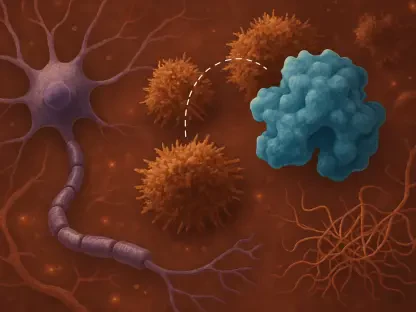The fight against obesity and type 2 diabetes (T2D) has seen numerous advancements over the years, but the introduction of tirzepatide marks a potential game-changer. This article delves into the efficacy of tirzepatide in weight reduction and diabetes prevention, drawing insights from the comprehensive SURMOUNT-1 trial. By targeting dual pathways, transcending the limitations of traditional treatments, and demonstrating remarkable results in various health metrics, tirzepatide may revolutionize the management of obesity and T2D.
Understanding Tirzepatide
Mechanism of Action
Tirzepatide stands out due to its dual agonist mechanism, targeting both GLP-1 (glucagon-like peptide-1) and GIP (glucose-dependent insulinotropic polypeptide) receptors. Unlike single-pathway therapies, this innovative approach enhances glycemic control more effectively. By improving insulin sensitivity and promoting glucose-dependent insulin secretion, tirzepatide aids in achieving better metabolic balance, a crucial aspect in managing obesity and preventing diabetes. The dual action approach distinguishes tirzepatide from earlier drug therapies, offering a potential breakthrough for patients and healthcare providers.
The GLP-1 receptor agonists have long been used in T2D management, but the addition of GIP receptor targeting adds a novel dimension. By addressing both incretin pathways, tirzepatide not only helps in reducing blood sugar but also promotes satiety and reduces food intake, leading to significant weight loss. This comprehensive mechanism makes it a promising candidate for those who struggle with both obesity and managing their blood sugar levels. Consequently, understanding this unique action is vital in appreciating the potential impact of tirzepatide on public health.
Comparison with Traditional Treatments
Traditional treatments for obesity and T2D often focus on single pathways, which can limit their effectiveness and scope in addressing these complex conditions. Treatments like metformin or GLP-1 receptor agonists provide benefits, but their single-pathway focus means they might not address all aspects of metabolic dysfunction. Tirzepatide’s dual receptor agonism represents a significant advancement, offering a more comprehensive approach that bridges the gap left by older medications.
This unique mechanism not only aids in more substantial and sustained weight loss but also significantly reduces the risk of developing T2D. The addition of GIP receptor activity provides a novel route to enhance insulinotropic effects, which complement the known benefits of GLP-1 receptor agonism. Patients treated with tirzepatide benefit from improvements in both weight and glycemic control, presenting an all-encompassing solution. This dual-hitting approach also suggests potential for broader cardiometabolic advantages, making tirzepatide a holistic option in addressing obesity and diabetes.
The SURMOUNT-1 Trial
Study Design and Participants
The SURMOUNT-1 trial is a phase-3, double-blind, randomized, placebo-controlled study involving 1,032 participants. This large-scale study monitored participants over an extended period, focusing on both weight loss and the progression or prevention of T2D. The rigorous design and substantial sample size lend credibility to the findings. By incorporating a diverse participant pool and maintaining stringent controls, the study results offer robust evidence.
The trial’s design aimed at eliminating biases and ensuring consistent oversight, which adds to the reliability of the data. Participants were randomly assigned to receive varying doses of tirzepatide or a placebo, with consistent monitoring over several years. The long-term nature of the study allowed for the observation of sustained effects, providing valuable insights into tirzepatide’s efficacy and safety profile. Such a comprehensive setup underscores the thorough examination of tirzepatide’s potential in real-world settings, crucial for clinical recommendations.
Key Findings on Weight Reduction
The trial revealed remarkable weight loss results among participants treated with tirzepatide. At week 176, those on a 5-mg dose experienced an average weight reduction of 12.3%, while those on 10-mg and 15-mg doses saw reductions of 18.7% and 19.7%, respectively. In stark contrast, the placebo group only achieved a 1.3% weight loss, highlighting tirzepatide’s effectiveness. These substantial differences underscore how tirzepatide outperforms traditional treatments, making it a promising agent for severe obesity cases.
Such dramatic weight reductions have profound implications for patient health, potentially reversing obesity-related conditions over time. Beyond the numerical decrease on the scales, weight loss at these levels can lead to decreased risks of cardiovascular diseases, improved mobility, and enhanced quality of life. For many patients, achieving and maintaining significant weight loss has been a challenge with existing therapies. The SURMOUNT-1 trial’s outcomes showcase that tirzepatide may provide a much-needed solution for long-lasting weight management.
Impact on Diabetes Prevention
Tirzepatide also demonstrated a significant reduction in the onset of T2D. Only 1.3% of participants receiving tirzepatide developed T2D, compared to 13.3% in the placebo group. This substantial difference underscores the drug’s potential in diabetes prevention, with a statistically significant hazard ratio of 0.07 (P
By effectively delaying or preventing the onset of T2D, tirzepatide could alter the trajectory of metabolic health for many individuals. This preventive aspect is a game-changer, as current treatments primarily focus on managing existing diabetes rather than preventing it. The ability to curb the progression from prediabetes to diabetes could substantially reduce the burden on healthcare systems and improve long-term health outcomes for high-risk populations. These compelling findings from SURMOUNT-1 reinforce tirzepatide’s role as a preventive therapeutic breakthrough.
Cardiometabolic Health Benefits
Improvements in Cardiometabolic Markers
Beyond weight loss and diabetes prevention, tirzepatide positively impacted several cardiometabolic markers. Participants experienced reductions in waist circumference, blood pressure, and improvements in lipid profiles. These changes contribute to overall better health and reduced risk of cardiovascular diseases like coronary artery disease and stroke. The broad spectrum of benefits highlights how tirzepatide can improve overall metabolic health, extending beyond just weight and sugar control.
The reduction in waist circumference, for instance, indicates a decrease in visceral fat, which is closely associated with cardiovascular risks. Lower blood pressure levels contribute significantly to heart health, reducing the likelihood of hypertension-related complications. Improvements in lipid profiles, such as increased HDL cholesterol and decreased LDL cholesterol, make tirzepatide a comprehensive therapy that supports holistic health improvements. The combination of these effects positions tirzepatide as a multi-faceted approach to managing complex metabolic disorders.
Enhanced Quality of Life
Quality of life indicators also showed significant enhancements among those treated with tirzepatide. Standardized health scales such as SF-36 and IWQOL-Lite reflected higher scores, indicating improved physical and mental well-being. These improvements are crucial for long-term health and patient satisfaction, as managing obesity and diabetes often entails significant lifestyle changes and psychological stress. The positive impact on quality of life adds substantial value to tirzepatide’s therapeutic profile.
Improved physical well-being manifests in better mobility, less pain, and enhanced vitality, enabling patients to engage more fully in daily activities and recreational pursuits. Mental well-being also sees a boost, as the success in managing weight and health conditions can alleviate anxiety and depression associated with chronic illnesses. This holistic improvement underlines tirzepatide’s role not just as a weight loss or diabetes medication, but as a comprehensive agent fostering overall health and happiness. These quality-of-life enhancements further validate tirzepatide’s potential to transform patient outcomes.
Safety and Tolerability
Common Adverse Events
While tirzepatide is generally well-tolerated, some adverse events were reported, primarily gastrointestinal issues like nausea, constipation, and diarrhea. These side effects were mostly mild to moderate and occurred mainly during the initial dose-escalation phase. Managing these side effects involved gradual dosing adjustments and providing supportive care, ensuring patient comfort and compliance. Most patients adapted as their bodies adjusted to the treatment, suggesting the long-term tolerable nature of the medication.
Several patients experienced temporary discomfort, which typically resolved as therapy continued. The commonly reported gastrointestinal symptoms are often seen with incretin-based therapies, suggesting tirzepatide’s side effect profile is not unique but manageable. These gastrointestinal effects highlight the need for proper patient education and engagement to maintain adherence and optimize the therapeutic experience. Understanding these common adverse events enables healthcare providers to monitor and mitigate symptoms, ensuring sustained treatment benefits.
Serious Adverse Events
A minority of participants experienced serious adverse events, including pancreatitis, cholelithiasis, and cholecystitis. Although these events were relatively uncommon, they highlight the importance of careful monitoring and patient selection to ensure safety. For patients with preexisting conditions or those prone to such complications, healthcare professionals must weigh the benefits and risks carefully before initiating tirzepatide therapy. Proper screening and regular monitoring can help mitigate these risks.
The occurrence of serious adverse events stresses the need for vigilant follow-up and personalized therapeutic plans. While the incidence rate was low, understanding these potential risks ensures healthcare providers can make informed decisions and manage any complications promptly. The balance between safety and efficacy must be carefully considered to optimize patient outcomes. Knowing the signs and symptoms of serious adverse reactions allows for early intervention, maintaining patient safety throughout the treatment regimen.
Broader Implications and Future Directions
Medical Community Consensus
There is a growing consensus in the medical community regarding tirzepatide’s effectiveness in weight management and diabetes prevention. The dual receptor agonism targeting both GLP-1 and GIP pathways is seen as a significant advancement over earlier treatments, offering a more holistic approach to managing obesity and T2D. Medical professionals acknowledge the potential of tirzepatide to bridge gaps in current treatment modalities, enhancing patient care comprehensively.
This consensus is based on substantial evidence from rigorous clinical trials like SURMOUNT-1, which provided data on the wide-ranging benefits and safety of tirzepatide. The medical community’s endorsement is key to the broader acceptance and integration of tirzepatide into clinical practice. Such agreement also fosters further research, likely leading to advancements that refine dosing, identify ideal patient profiles, and explore long-term effects. The consensus reflects the transformative potential of tirzepatide, inspiring confidence among practitioners and patients alike.
Potential to Transform Treatment Landscape
The battle against obesity and type 2 diabetes (T2D) has seen significant advancements over the years, but the introduction of tirzepatide presents a potential breakthrough. This article explores the efficacy of tirzepatide for weight loss and diabetes prevention, highlighting findings from the extensive SURMOUNT-1 trial. By targeting two pathways simultaneously, this new treatment surpasses the limitations of traditional medications and exhibits impressive results across various health metrics. Tirzepatide’s dual-action mechanism addresses both weight reduction and insulin resistance, positioning it as a potentially revolutionary tool in managing obesity and T2D. This novel approach may offer hope to millions of people struggling with these conditions, providing a more effective and comprehensive solution. Unlike conventional treatments that often tackle just one aspect of these complex diseases, tirzepatide’s ability to target multiple pathways sets it apart, potentially transforming the landscape of diabetes and obesity treatment and management for the better.









